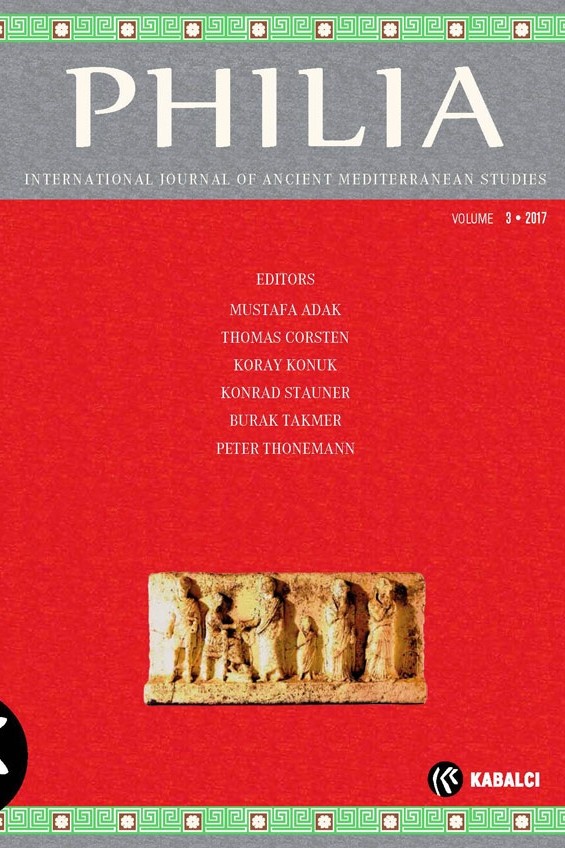Phrygische und lydische Denkmäler im Museum von Çeşme
Phrygische und lydische Denkmäler im Museum von Çeşme
When studying the epigraphic documents of Erythrai, the author noticed a number of inscriptions in the museum of Çeşme which stem from the Lydian-Phrygian region. These monuments are likely to have found their way to said museum through confiscation, as otherwise only material from the Mimas Peninsula is stored there. Eight inscriptions from Lydia had been published previously (s. appendix). The remaining four stones are presented here for the first time. The funerary stele of Damas (no. 1) originates from the upper Tempris valley, the decisive point for the geographical allocation being the remark that during his lifetime the deceased had been honoured by the god-dess Hekate. This remark can be found also on some other steles from that region. The style of the fragmentary funerary stele no. 2, which was set up for an unknown married couple, is similar to that of steles manufactured in the Katakekaumene in the vicinity of Kula. The dedicatory monu-ment no. 3, which features a diseased hand, appears to come from the same region. The funerary stele no. 4 was erected by the brothers Diogenes and Charikles for their mother. The name of the deceased women is, however, not mentioned in the otherwise complete inscription. All four mo-numents date from Roman imperial times.
Keywords:
Lydia, Phrygia, dedications, grave monuments Hekate,
___
- Chaniotis 1995 A. Chaniotis, Illness and Cures in the Greek Propitiatory Inscripti-ons and Dedications of Lydia and Phrygia, in: J. Horstmanshoff – Ph. J. van der Eijk – P. H. Schrijvers (Hgg.), Ancient Medicine in its Socio-Cultural Context. Papers Read at the Congress Held at Leiden University, 13–15 April 1992, Amsterdam – Atlanta 1995, 323–344.
- Forsen, Gliederweihungen B. Forsen, Griechische Gliederweihungen. Eine Untersuchung zu ihrer Ty¬po¬¬logie und ihrer religions- und sozialgeschichtlichen Be-deutung, Helsinki 1996 (Papers and Monographs of the Finnish In-stitute at Athens, vol. 4).
- Hirschmann 2003 V. Hirschmann, Der Schatten der Unsterblichkeit. Der Priester und Prophet Epitynchanos, Epigr. Anat. 36, 2003, 137–152.
- I.Ephesos H. Wankel – C. Börker – H. Engelmann – R. Merkelbach u.a., Die In-schrif¬ten von Ephesos I–VIII, Bonn 1979–1984 (IK 12-17,4).
- I.Erythrai H. Engelmann – R. Merkelbach, Die Inschriften von Erythrai und Klazo-menai, 2 Bde., Bonn 1972 (IK 1–2).
- Keil – Premerstein, Reise II J. Keil – A. von Premerstein, Bericht über eine zweite Reise in Ly-dien, Wien 1911 (Denkschriften ÖAW, phil.-hist. Kl. 54,2).
- Le Bas – Waddington, Inscriptions Ph. Le Bas – W.H. Waddington, Inscriptions grecques et latines recueillies en Asie Mineure, I–II, Paris 1870 (ND Hildesheim – New York 1972 [Subsidia Epigraphica 1, 2]).
- LGPN VA Th. Corsten (Hrsg.), A Lexicon of Greek Personal Names, vol. V, A. Coas¬tal Asia Minor: Pontos to Ionia, Oxford 2010.
- Lochmann, Studien Th. Lochmann, Studien zu kaiserzeitlichen Grab- und Votivreliefs aus Phry¬¬gien, Basel 2003.
- Malay, Researches H. Malay, Researches in Lydia, Mysia and Aiolis, Wien 1999 (Denkschriften ÖAW, phil.-hist. Kl. 279).
- Masséglia 2013 J. Masséglia, Phrygians in relief: trends in self-representation, in: P. Thone¬mann (Hrsg.), Roman Phyrgia: : Culture and Society, Oxford 2013, 95–123.
- Merkelbach – Stauber, SGO R. Merkelbach – J. Stauber, Steinepigramme aus dem griechischen Osten, 5 Bde., Stuttgart – Leipzig bzw. München – Leipzig 1998–2004.
- Mitchell, Anatolia St. Mitchell, Anatolia. Land, Men, and Gods in Asia Minor, I. The Celts and the Impact of Roman Rule, II. The Rise of the Church, Oxford 1993.
- Nock 1925 A. D. Nock, Studies in the Graeco-Roman Beliefs of the Empire, JHS 45, 1925, 84–101.
- Paz de Hoz 1998 M. Paz de Hoz, The Verb KΑΘΙΕΡΟΩ and reference to a Divinity in Anatolian Funeral Formulas», Arkeoloji Dergisi 5, 1998, 161–167.
- Petzl, Beichtinschriften G. Petzl, Die Beichtinschriften Westkleinasiens, Bonn 1994 (Epigr. Anat. 22).
- Petzl 1978 G. Petzl, Vier Inschriften aus Lydien. in: Studien zur Religion und Kultur Klein¬asiens. Festschrift für Friedrich Karl Dörner, Bd. II, Leiden 1978, 745–755.
- Pfuhl – Möbius, Grabreliefs E. Pfuhl – H. Möbius, Die ostgriechischen Grabreliefs I–II, Mainz am Rhein 1977/1979.
- Waelkens 1984 M. Waelkens, Privatdeifikation in Kleinasien und in der griechisch-rö¬mischen Welt. Zu einer neuen Grabinschrift aus Phrygien, in: L. Donceel – R. Leburn (Hgg.), Archéologie et religions de lʼAnatolie ancienne: Mélan¬ges en lʼhonneur du professeur Paul Naster, Lou-vain-la-Neuve 1984, 259–307.
- Zgusta, KPN L. Zgusta, Kleinasiatische Personennamen, Prag 1964.
- ISSN: 2149-505X
- Başlangıç: 2015
- Yayıncı: Kabalcı Yayıncılık
Sayıdaki Diğer Makaleler
Erythrailı Koşucu Marcus Aurelius Nikomakhos
Homeros’un Dinleyici Kitlesi: Homeros’un Dinleyicileri Kimlerdi?
Hermogenes ve Kaikos’un Küçükbaş Hayvanları (TAM V 1, 464)
Bazı Lykia Tanrılarına İlişkin Öneriler
Phrygische und lydische Denkmäler im Museum von Çeşme
Kapadokya’dan Maximinus Thrax Dönemine Ait İki Yeni Miltaşı
Attalos I ve Pessinus’un Fethi. I.Pessinus 1 Hakkında Değerlendirme
Magastara Yer İsmi (Sagalassos Territoryumu)
